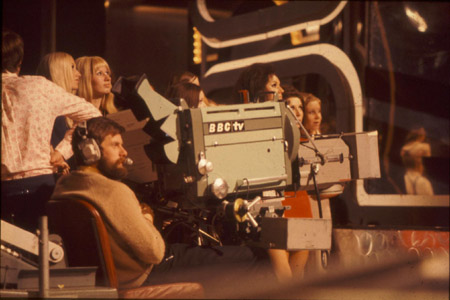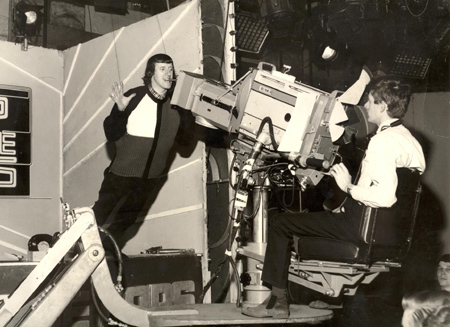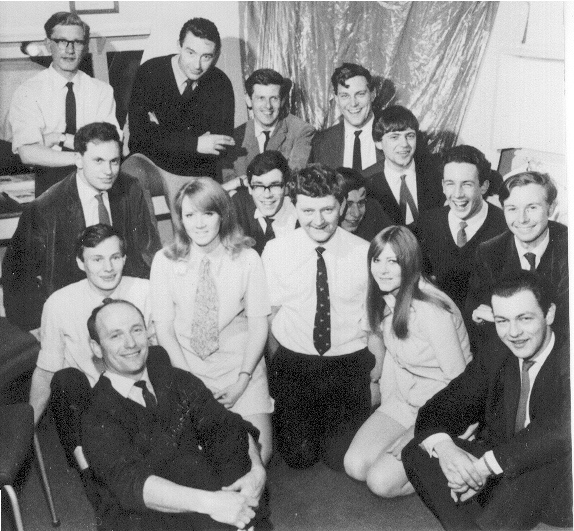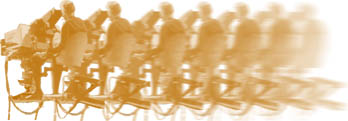

| From Chris Wickham Some pictures from the Johnny Stewart era of Top of the Pops when Harry Goodwin was the official photographer. In the right hand photo Jimmy Savile is on a Kirby wire. |
 |
 |
|
When I (Bernie) look at photos like these - Chris relaxed in his seat, possibly rather bored in the left photo, I know that we didn't in any way realise
that a long time after we'd be part of history.... And just to divert for a moment - an appropriate video - come back when you've watched. Next here's a group photo - there are similar ones much further back. Chris says "The people seen are front left Ron Peverall (Senior Cameraman) and right Vernon Dyer (Cam 5). Behind Ron is a very young Robin Sutherland (dollyop)then an unknown girl (makeup maybe), John Milner (SA1), another unknown girl. Behind Robin is Ian Perry (Cam4) then an unknown chap with glasses (probably sound), half hidden behind John Milner I think is Chris Maurice (sound), Don McQuistan (dolly op, laughing) and John Hoare ( dolly op). Back row are bespectacled unknown young man (I think sound)(I think Alan Machin (Bernie)), Alan Kerridge (cam 2), myself (cam3), Mike Conder (SA2), Dave Brook(dolly op ,with Beatle haircut). To those who's names I have forgotten, misspelled or who's crew position is wrong, I apologise profoundly. Looking at the picture today, the thing that immediately strikes me is that everyone is wearing a tie." (...just a mid-20th century fashion fad! B.) |
 |
| Now, by way of contrast, a story from Roger Bunce Experiment with the Air Pump Alexandra Palace, 1972 (or possibly late ’71). Today is to be one of those avant-garde, experimental, workshop sessions for the Open University. The subject is “Learning through Play”. Three students (or junior academics) have been given a new “Toy”, and they are going to play with it in a spontaneous, imaginative, uninhibited sort of way. Three cameras will photograph them, also in a spontaneous, imaginative, uninhibited sort of way. And this will become the basis of a spontaneous, imaginative and uninhibited discussion about learning through play. The “Toy” consists of a pump which blows air upwards through a vertical tube. It comes with a selection of light-weight objects: corks, ping-pong balls, feathers and pieces of polystyrene, which can be made to hover on the rising column of air. Two of the cameramen were David Carter and Roger Bunce, both on attachment from TV Centre. The Vision Mixer was Rhoda Carss (I think). All other names have been forgotten, but if anyone recognizes themselves, please write in. Take One. For maximum coverage, the Director decides to shoot “in the round”, positioning his three cameras in a circle around the action, 120 degrees apart, all facing inwards. But the first attempt comes to a halt, because he doesn’t like seeing cameras in shot. The chaos of eye-lines seems to be less of a worry. We reposition ourselves in a more conventional formation. Take Two. The Director’s other instruction to us is to be spontaneous, imaginative and uninhibited in our photography. We must take any shot, however unconventional, that we feel inspired to take at the time. “If you feel like taking a close-up of someone’s left ear,” he says, “then you must take a close-up of that left ear.” We do as we’re told, with the result that the next attempt also comes to a halt. All three cameras are pointing at the same student. The reason for this might not be apparent to the academic mind, but it probably arises from the fact that all three cameramen are male, and that only one of the students is a pretty lady. Once again, we abandon imaginative spontaneity and fall back on conventional coverage. We decide amongst ourselves who is going to shoot what, and the Director even calls a few shots. Take Three. This also grinds to a halt. Nothing wrong with the shots this time, but the students can’t think of anything imaginative or experimental to do with their “Toy”. A gaggle of academicals descends upon the studio. The students explain that they feel inhibited by all the cameras looking at them, and by the lights, microphones and other technology. Also, that silly air pump isn’t versatile enough. It allows insufficient scope for imaginative, experimental play. Students and academics go into a huddle in the corner. The discussion becomes very high-brow and intellectual. It continues for a long time. David Carter and Roger Bunce run out of small talk and become bored. There has been no mention of a tea break. Rhoda (?) the Vision Mixer is also bored. She comes out of the gallery to join us, and we are all bored together – extremely bored. In fact, we become so bored that we wander over to look at the “Toy”. Idly, we turn it on an off, feeling the draught. Then in a half-hearted, purely-because-we-can’t-think-of-anything-better-to-do sort of way, we try balancing objects on the rising air column. Some of them just fall off. The lightest ones, the feathers, flutter away. But, with a bit of skill, some of them can be made to hover. Depending on shape and weight, they hover at different heights. Some seem perfectly stable; others yo-yo up and down; while others rotate. It becomes more interesting when we start joining things together, to create compound flying machines. A piece of polystyrene with a single feather stuck into it might be expected to hover with the feather upwards, like a vertical wind-vane. In fact, it hovers horizontally, with the feather sticking out on one side, causing the whole thing to spin like a helicopter. What if we angle the feather, like a wing, can we change the direction of rotation? Maybe we should use two feathers, placed symmetrically, like a propeller? Can we balance two objects, one above the other, and set them rotating in opposite directions? By now we are so engrossed in our experiments that we initially fail to hear the silence which has fallen over the studio. The intellectual huddle has broken up. Academics and students are now standing in a line, arms folded, staring at us. Guiltily, we stop playing, and shuffle away. Then one of the academics says, “There’s only one thing to do. We’ll have to record them!” Take Four. And that’s what happens. Some spare bods are found to operate the cameras and press the buttons, while David, Roger and Rhoda (?) play silly games with an air pump. It’s not quite so spontaneous this time, since we have to start from the beginning, recreating our initial discoveries, before moving on to further experiments. I think we managed it convincingly. After all, we have a long experience of recreating our rehearsals. I never did see the tape, nor do I know whether it was ever used as part of a broadcast programme. There may be a deep meaning to all this: an insight into the mentality of Cameramen. I forget which review of which programme included the words, “Even the Cameraman were laughing!” The implication was that it was a major achievement to get any kind of reaction out of those cynical, world-weary technicians. This is the way the media portray us, on the rare occasions they remember our existence. In this story, we technicians start true to stereotype: bored, cynical; the custodians of convention; resistant to the imaginative, experimental ideas of the intellectuals. But, in the end, after avant-garde intellectualism has been defeated by a simple toy, it is only we techies who are sufficiently free-thinking and imaginative to actually play with it. I’m sure there’s a moral there . . . somewhere. |
 |